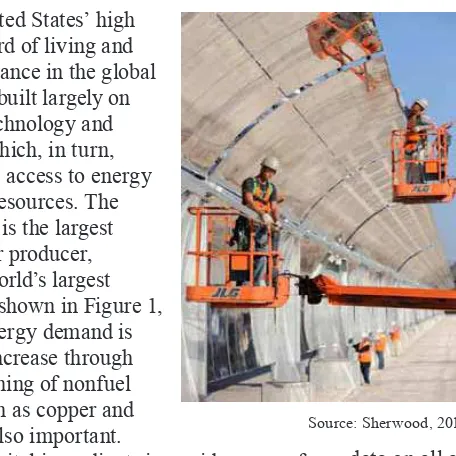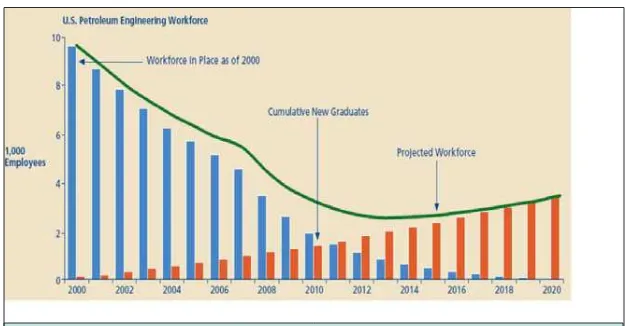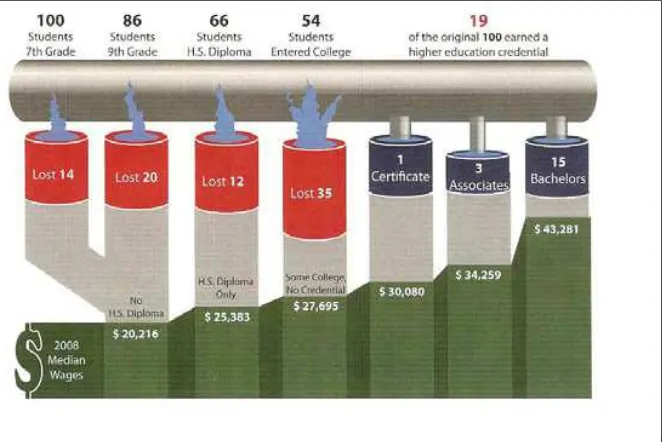T
he United States’ high standard of living and importance in the global economy are built largely on mastery of technology and innovation, which, in turn, depends upon access to energy and mineral resources. The United States is the largest electric power producer, serving the world’s largest economy. As shown in Figure 1, worldwide energy demand is expected to increase through 2035. The mining of nonfuel minerals, such as copper and platinum, is also important.Minerals are vital ingredients in a wide range of everyday products, the combined industries of which contributed $2.2 trillion to the U.S. gross domestic product (GDP) in 2011.
This report summarizes available data [click here for more] on the current and projected future workforce for the U.S. energy and mining industries (including oil, natural gas, coal, nuclear, solar, wind, geothermal, carbon capture utilization and storage, and nonfuel mineral mining). The report also addresses challenges and opportunities for maintaining the work-force, including the “pipeline” from K-12 to post-secondary educational institutions
and programs, including community colleges, universi-ties, vocational technical institutes, specialty training facilities and programs, and apprenticeship programs.
Workforce and Pipeline
Trends
Workforce information and data are available from a range of sources, including federal, industry, industry association, professional society, and academic sources. No single entity collects, analyzes, and reports data on all aspects of the energy and mining workforce. Instead, different entities collect and analyze data for their own particular purposes and using their own methods. This makes As the baby boom generation is beginning to retire, the United States is facing the loss of a large number of experienced energy and mining workers in industry, academia, and the government. At the same time, the current educational system is not producing enough quali-ied workers to ill future jobs, which increasingly require science and math skills. Some innovative solutions are being pursued, but more action is needed if the nation is to maintain a skilled workforce able to supply energy and mineral needs.
Emerging Workforce Trends in the
U.S. Energy and Mining Industries
Figure 1. Growing Energy Demand. The Energy Information Administration is projecting a steady increase in U.S. demand for energy through 2035. An international increase is also expected.
direct comparisons of data from different sources dificult and imprecise, and combining data sets generally impossible.
Despite their substantial shortcomings, the avail-able data and information do provide a clear indication of the general nature of the energy and mining work-force and the important trends, issues, and concerns related to it. The data indicate a bright present and future for energy and mining jobs. Demand for workers at all levels will remain strong for the foresee-able future and these jobs will continue to pay well.
Nonetheless, several factors pose a threat to maintain a suficient energy and mining workforce, and their negative impacts will grow unless
addressed. One major factor is that baby boomers comprise about a third of the U.S. workforce, and they are poised to retire in great numbers by the end of this decade. For example, projections from the Mine Safety and Health Administration show that 46 percent of its coal-sector workforce will be eligible to retire within 5 years. Not only are there too few younger workers in the pipeline to replace them (see Figure 2), but there is little time to capture the knowl-edge of experienced employees before they leave.
Another major crosscutting factor is that a strong foundation in science, technology, engineering, and math (STEM) skills is needed for many energy and mining jobs. However, the current pipeline of STEM-capable students and workers is inadequate to meet
workforce needs. Stem education begins in K-12, but the poor preparation of high school students is well known. High dropout rates and a lack of alternative pathways to high school graduation are also problems.
A common, serious problem is a faculty shortage, which impacts the oil and gas, mining, and geothermal workforces, and possibly eventually the carbon capture and storage workforce. Unless this is corrected, the nation risks losing its capacity to provide new science and engineering professionals for the workforce.
Pathways to Energy and Mining Careers
Industry-education partnerships, particularly at community colleges or in the irst 2 years of higher education, have emerged as critical to the nation’s energy and mining future. They are designed to create competency-based educational pathways to careers in industry. Successful models exist in manufacturing— closely aligned to the energy industry—and in several energy sectors (nuclear power, electrical transmission, and most recently, renewable energy).Community colleges are proving to be the best vehicle for delivering the technician-level, skills-based education that the energy and mining
industries need in a STEM technical workforce. They provide postsecondary education from 1-year certii -cates through associate’s degrees, and are often the irst 2 years of higher education leading to degrees in 4-year institutions.
The committee learned of a number of ongoing efforts by a variety of educational institutions that have established excellent pathways to address the workforce issues. Recognizing and emulating these 19 successful programs could help realize great beneits. Opportunities also exist to attract young people,
including ethnic minorities and women, into STEM programs and technical programs that lead to energy and mining careers.
Strategies for Addressing the
Challenges
The report identiies a number of strate -gies that can help to address the looming shortage of U.S. energy and mining workers. Click here for the committee’s
overarching indingsand
recommendations.
Education Initiatives
Traditional routes to degrees in higher education do not adequately align curric-ulum to energy and mining industry Growing energy and mining sectors, combined with a
current workforce that is aging and preparing to retire, are creating many new opportunities for young people
interested in these ields.
Figure 2. The U.S. petroleum industry is illustrative of the challenge. As vast numbers of engineers have retired, there are not enough graduates to replace them. Blue columns are the workforce in place as of 2000, red columns are cumulative new graduates, and the green curve is the projected workforce.
requirements, they are increasingly not affordable and accessible and, therefore, do not provide enough qualiied STEM-educated workers and professionals to fulil the nation’s energy and mining work-force needs. The goal in addressing the shortfalls of the current educa-tion pipeline is to create an
education system that can respond to changes in the economy more quickly and produce a more lexible, STEM-competent workforce.
Recommendation 1: The Department of Education, in collaboration with the Department of Labor, state departments of education, and national industry organizations, should convene (perhaps in workshops or as a working group) critical industry, government, and educational leaders to create and support new approaches that provide multiple path-ways in higher education that take full advantage of the attributes of our higher education system. These models would beneit greatly from including, for example, the industry-education partnerships and community college programs described above.
Business-Education-Government Partnership No one sector—government, industry, or education— can provide the needed energy and mining workforce on its own. University research also can contribute to workforce development by enhancing the education pipeline.
Recommendation 2: To address common goals and to provide a mechanism for industry’s engage-ment with the education process and the graduates it produces, federal agencies (e.g., the National Science Foundation, Department of Energy, Department of Defense, National Institute for Occupational Safety and Health, and National Institutes of Health) should consider providing increased research funding to universities, with matching funding from industry,
with speciic requirements to incorporate two
outcomes from the research: (1) advancing technology or business processes to drive innovation and enrich graduate and undergraduate education; and (2) devel-oping university faculty who work on the cutting edge of research to enhance the quality of higher education.
Energy and Mining Information for the Public Building the best educational pathways in the world does not guarantee that more students will pursue energy and mining programs of study. A negative public perception of U.S. extractive industries due, for example, to concerns over pollution, noise, environ-mental degradation, and health issues, dissuades some from pursuing careers. Although renewable energy is generally seen as positive, issues such as questionable technology and market viability may be a deterrent. Information about all of these industries can educate the public about their importance to the nation and the career opportunities they offer.
Recommendation 3: National industry organiza-tions, in partnership with educational instituorganiza-tions, should embark on a national campaign to create and provide accurate and timely information on the indus-tries and their careers, educational and career
navigation resources, and experiential learning oppor-tunities to explore jobs and career paths in energy and mining.
Recommendation 4: In like fashion, national industry organizations and educational institutions should also embark on an informational campaign to educate students, parents, educators, and public U.S. Report Card on
Education About 7,000 students drop out of high school every school day in the U.S., and about 1.3 million students do not graduate each year. Also, in 2011, only 25 percent of graduating high school seniors met or surpassed the four ACT College Readiness Benchmarks in the areas of science, math, reading, and English.
Committee on Emerging Workforce Trends in the U.S. Energy and Mining Industries: Elaine T. Cullen (Co-Chair), Safety Solutions International, Chattaroy, Washington; Charles Fairhurst (Co-Chair), Itasca Consulting Group, Minneapolis, Minnesota; Kathleen A. Alfano, College of the Canyons, Santa Clarita, California; Burt A. Barnow, George Washington University, Washington, D.C.; Sally M. Benson, Stanford University, California; Emily Stover Derocco, E3, Washington, D.C.; Leigh Freeman, Downing Teal Inc., Denver, Colorado; John A. Pappas, Texas A&M University, College Station; Roy Radner, New York University, New York; Joel L. Renner, Geothermal Consultant, Inver Grove Heights, Minnesota; Sterling Rideout, Jr, U.S. Department of Interior, Washington, D.C.; Kenneth C. Rogers, U.S. Nuclear Regulatory Commission (Retired), Rockville, Maryland; Reginald Spiller, Azimuth LLC, Houston, Texas; Jerry Ventre, Photovoltaic Systems Engineering Consultant, Oviedo, Florida; Cy Butner (Study Director), Elizabeth A. Eide (Director of the Board on Earth Sciences and Resources), Gail Greenield (Senior Program Oficer), Nicholas D. Rogers (Financial and Research Associate), Courtney R. Gibbs (Program Associate), Jason R. Ortego (Research Associate, until June 2012), Chanda T. Ijames (Senior Program Assistant), National Research Council.
The National Academies appointed the above committee of experts to address the speciic task requested by
the U.S. Department of Energy. The members volunteered their time for this activity; their report is
peer-reviewed and the inal product signed off by both the committee members and the National Academies. This
report brief was prepared by the National Research Council based on the committee’s report.
For more information, contact the Board on Earth Sciences and Resources at (202) 334-2744 or visit http://dels.nas.edu/besr. Copies of Emerging Workforce Trends in the U.S. Energy and Mining Industries: A Call to Action are available for purchase from the National Academies Press, 500 Fifth Street, NW, Washington, D.C. 20001; (800) 624-6242; or as free PDFs at
www.nap.edu.
Permission granted to reproduce this brief in its entirety with no additions or alterations. Permission for images/igures must be obtained from their original source.
© 2013 The National Academy of Sciences
Read or purchase this report and locate information on related reports at
http://dels.nas.edu/besr
policy makers about the importance of the energy and mining industries to our economic and national security, the relevance of STEM education to jobs and careers in these industries, and job availability.
Data Needs
Although the federal (and other) databases provide an abundance of information on the energy and mining workforce, such as employment estimates and demographic information, the data currently available for addressing the energy and mining workforce are not suficiently consistent, compre -hensive and up-to-date for these rapidly evolving, technology-infused industries and they do not exist at a suficient degree of granularity.
Recommendation 5: The Department of Labor, through its Bureau of Labor Statistics (BLS), should determine and pursue a more effective way to partner with industry, through its national industry associations, to more quickly and accu-rately relect the fast-paced change of job and occupation titles and characteristics, as well as the levels of education and training required in 21st century jobs.
Recommendation 6: The BLS should work with industry and the Departments of Education and Labor to better deine the STEM technical
workforce needed to support STEM professions in our economy so that appropriate and useful data can be identiied, collected, and analyzed.
The Federal Workforce
Federal employees have a critical role in, and impact on, the success of the U.S. energy and mining indus-tries. They link industry’s ability to produce energy and minerals with civil society’s concerns about these industries. However, the National Nuclear Security Administration reports that a majority of mission-critical employees are currently eligible or will be eligible for retirement in the next 4 years. Other federal agencies are facing a similar situation.


